友情提示点击顶部放大镜 可以使用站内搜索 记住我们的地址 www.hainabaike.com
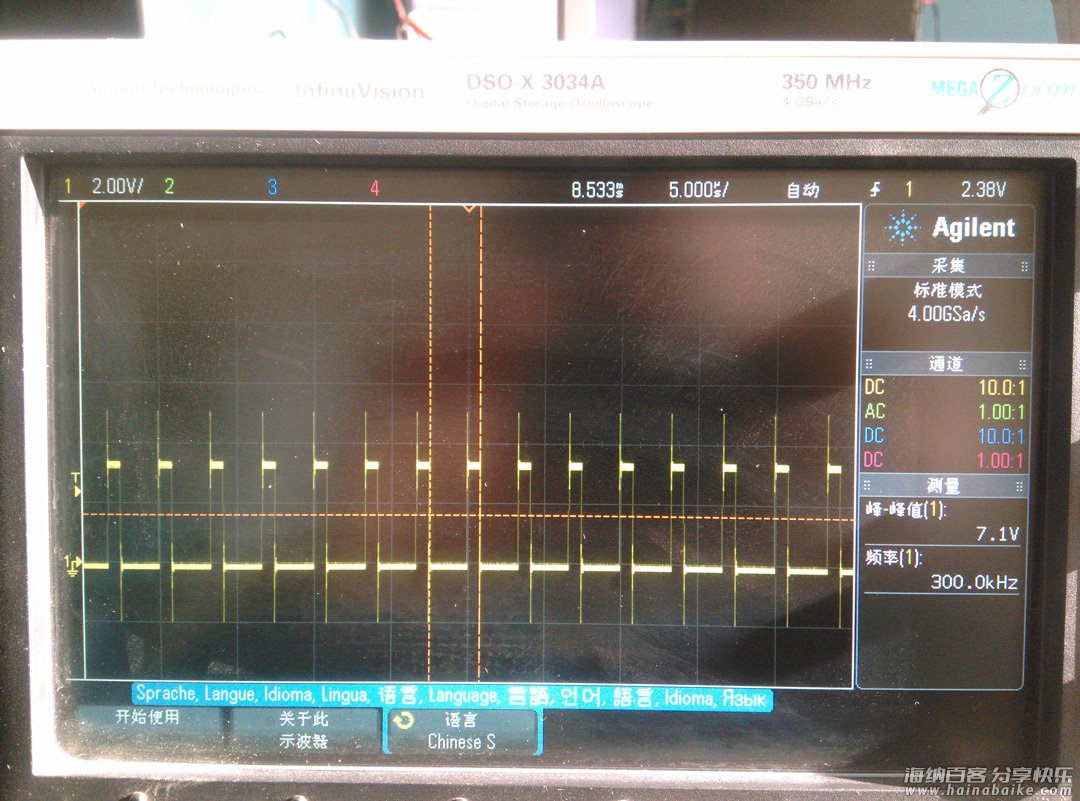
步进电机以及无源蜂鸣器这些都需要脉冲信号才能够驱动,这里将用GPIO的PWM接口驱动无源蜂鸣器弹奏乐曲,本文基于树莓派Mode B+,其他版本树莓派实现时需参照相关资料进行修改!
1 预备知识
1.1 无源蜂鸣器和有源蜂鸣器
无源蜂鸣器:内部没有震荡源,直流信号无法让它鸣叫。必须用去震荡的电流驱动它,2K-5KHZ的方波PWM (Pulse Width Modulation脉冲宽度调制)。5KHZ的电流方波就是每秒震动5K次,每一个完整的周期占用200us的时间,高点平占一部分时间,低电平占一部分时间。声音频率可控,可以做出不同的音效。
有源蜂鸣器:内部带震荡电路,一通电就鸣叫,所以可以跟前面LED一样,给个高电平就能响,编程比无源的更方便。
本文利用无源蜂鸣器弹奏乐曲,用的就是淘宝上普通的电磁式阻抗16欧交流/2KHz 3V 5V 12V通用无源蜂鸣器,如果手边没有无源蜂鸣器,用普通的耳机也可以来代替无源蜂鸣器。
1.2 PWM
PWM(Pulse Width Modulation)即脉冲宽度调制,是一种利用微处理器的数字输出来控制模拟电路的控制技术。可以用下面的一幅图来形象地说明PWM:

图中tpwm就是一个周期的时间长度。对于2KHz频率来说,那么周期就是1s/2K=500us。图中的D叫做占空比,指的是高电平的时间占用整个周期时间的百分比。第一个周期D=50%,那么就是高电平低电平的时间各占一半。接下来的D为33%,那就是通电时间为33%,剩余的不通电时间占用67%。树莓派Model B+有4个PIN脚支持PWM输出,如下图最右侧:

但是,需要注意的是BCM2835芯片只支持两路PWM输出,所以以上12 Pin脚和32 Pin脚对应的都是channel 1的PWM输出,即如果这两个Pin的功能都选择的是PWM输出,则它们输出的PWM是完全相同的,同理33 Pin脚和35 Pin脚对应芯片channel 2的PWM输出。
博通公司公布的BCM2835芯片资料BCM2835 ARM Peripherals中第9章比较详细的介绍了PWM相关内容,此外还可参考网上整理好的寄存器介绍资料rpi-registers,通过阅读可以得知树莓派Model B+支持两种模式的PWM输出:一种是Balanced mode(平衡模式),一种是Mark-Space mode(MS模式)。另外树莓派的PWM输出基础频率是19.2MHz,PWM输出频率受这个基础频率的限制。
1.3 树莓派PWM分析
进行分析前先看一下实验的物理电路连接:
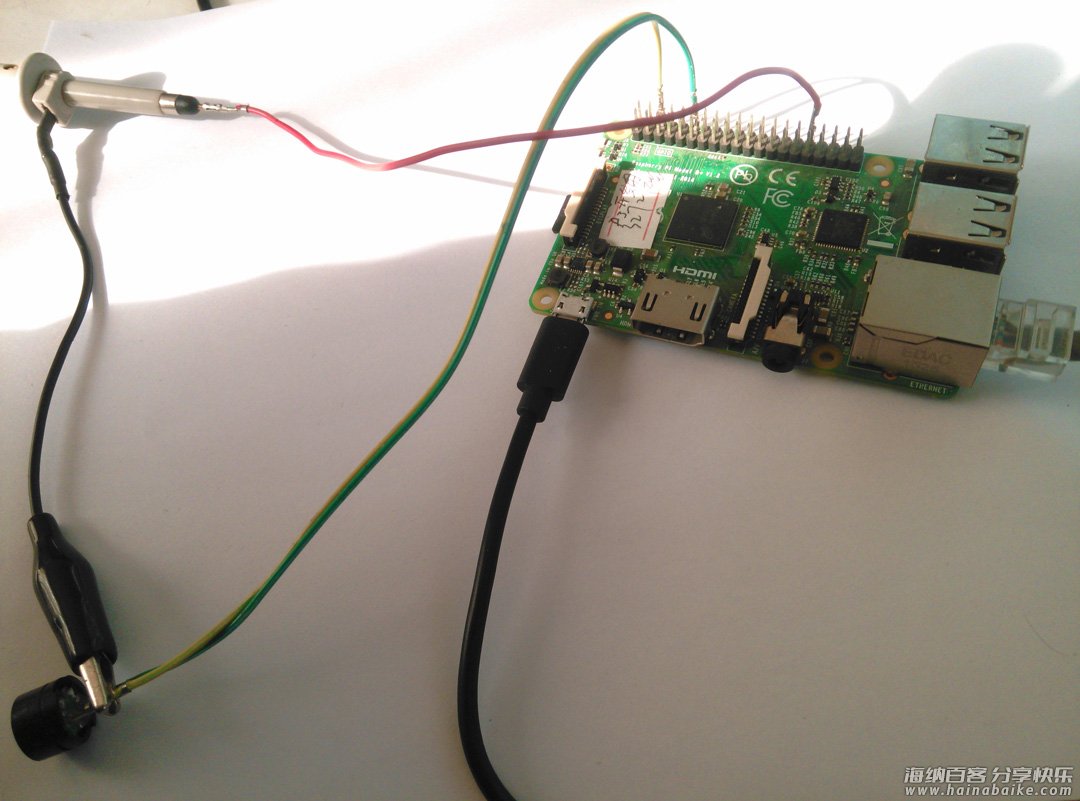
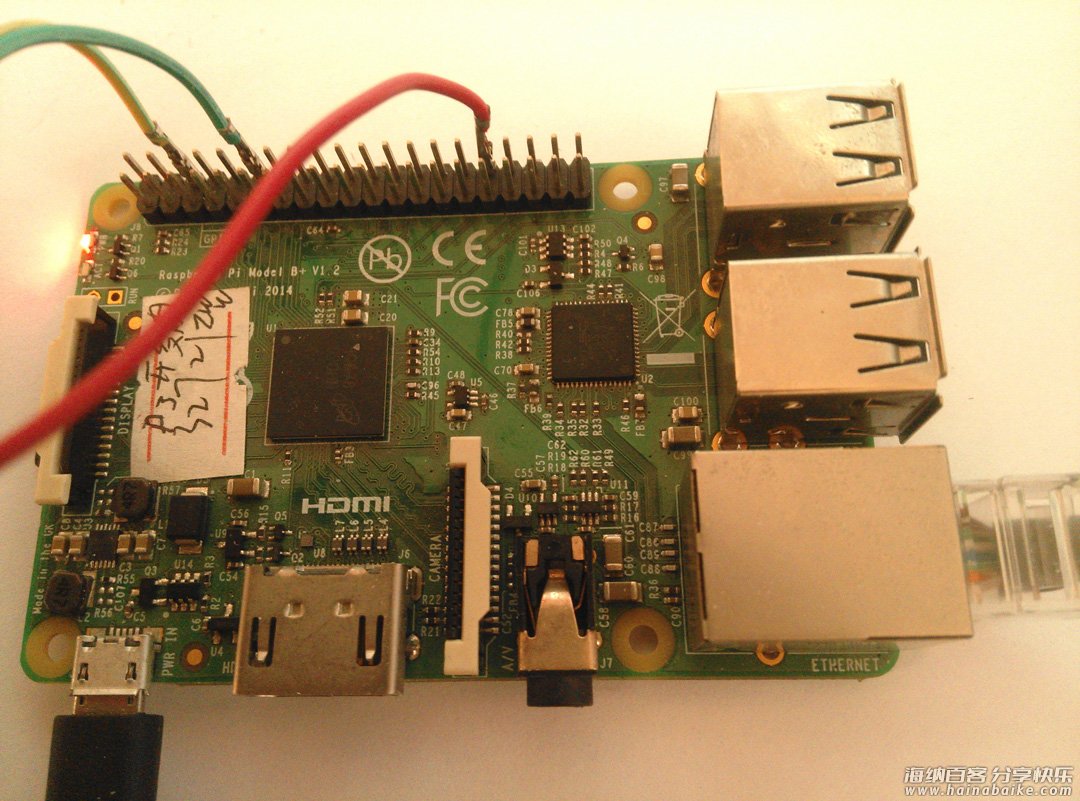
图中,红色杜邦线一头连接树莓派的32 Pin脚(PWM0),一头连接示波器的探针;绿色杜邦线一头连接树莓派的12 Pin脚(PWM0),一头连接无源蜂鸣器的正极;黄色杜邦线一头连接树莓派的6 Pin脚(ground),一头连接无源蜂鸣器的负极,此外示波器探针的ground也连接到黄色杜邦线,结合bcm2835 C library来进行分析:
#下载bcm2835库 wget http://www.airspayce.com/mikem/bcm2835/bcm2835-1.50.tar.gz #解压 tar -zxvf bcm2835-1.50.tar.gz #进入目录 cd bcm2835-1.35 #编译 ./configure && make #安装 sudo make install
修改examples/pwm/pwm.c的内容如下:
// pwm.c
//
// Example program for bcm2835 library
// Shows how to use PWM to control GPIO pins
//
// After installing bcm2835, you can build this
// with something like:
// gcc -o pwm pwm.c -l bcm2835
// sudo ./pwm
//
// Or you can test it before installing with:
// gcc -o pwm -I ../../src ../../src/bcm2835.c pwm.c
// sudo ./pwm
//
// Author: Mike McCauley
// Copyright (C) 2013 Mike McCauley
// $Id: RF22.h,v 1.21 2012/05/30 01:51:25 mikem Exp $
#include <bcm2835.h>
#include <stdio.h>
// PWM output on RPi Plug P1 pin 12 (which is GPIO pin 18)
// in alt fun 5.
// Note that this is the _only_ PWM pin available on the RPi IO headers
#define PIN RPI_GPIO_P1_12
// and it is controlled by PWM channel 0
#define PWM_CHANNEL 0
// This controls the max range of the PWM signal
#define RANGE 1024
#define PIN2 RPI_BPLUS_GPIO_J8_32
int main(int argc, char **argv)
{
if (!bcm2835_init())
return 1;
// Set the output pin to Alt Fun 5, to allow PWM channel 0 to be output there
bcm2835_gpio_fsel(PIN, BCM2835_GPIO_FSEL_ALT5);
bcm2835_gpio_fsel(PIN2, BCM2835_GPIO_FSEL_ALT0); // 打开PI 32 Pin脚的PWM0输出功能
// Clock divider is set to 16.
// With a divider of 16 and a RANGE of 1024, in MARKSPACE mode,
// the pulse repetition frequency will be
// 1.2MHz/1024 = 1171.875Hz, suitable for driving a DC motor with PWM
bcm2835_pwm_set_clock(BCM2835_PWM_CLOCK_DIVIDER_16);
bcm2835_pwm_set_mode(PWM_CHANNEL, 0, 1);
bcm2835_pwm_set_range(PWM_CHANNEL, RANGE);
printf("this is banlance mode, anykey will change to markspace mode
");
bcm2835_pwm_set_data(PWM_CHANNEL, RANGE/4);
getchar();
printf("change to markspace mode, anykey to exit
");
bcm2835_pwm_set_mode(PWM_CHANNEL, 1, 1);
bcm2835_pwm_set_range(PWM_CHANNEL, RANGE);
bcm2835_pwm_set_data(PWM_CHANNEL, RANGE/4);
getchar();
bcm2835_close();
return 0;
}
代码中首先设置PWM输出为平衡模式,之后按任意键切换为MS模式,编译:gcc -o pwm pwm.c -lbcm2835,运行:sudo ./pwm,示波器分别捕获到如下波形图:

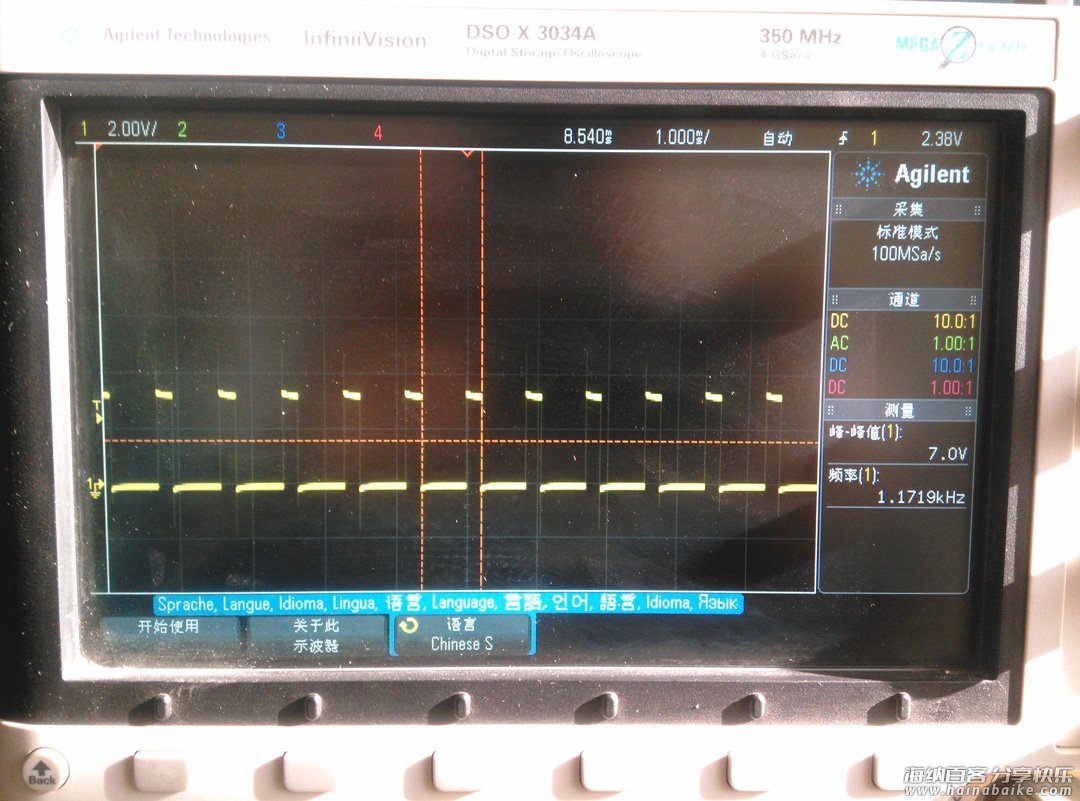
代码第47行用divider=16对19.2MHz的基础频率进行调整,调整后的pwm频率为19.2MHz/16=1.2MHz,根据BCM2835芯片资料及代码49行和52行内容可知占空比应为N/M=(RANGE/4)/RANGE=256/1024,平衡模式力求任意一段时间占空比都最接近N/M=1/4,即把256个高电平时钟周期平均的分配到1024个之中周期中,可以这样进行处理,每4个时钟周期为一组,其中的一个周期内为高电平,这样即可实现“平衡”,这时真实的PWM输出帧率为1.2MHz/4=300KHz,如以上左图所示;对于MarkSpace模式来说,占空比为M/S=(RANGE/4)/RANGE=256/1024,这种模式不需要进行平衡,即可以认为1024个时钟周期的前256个为高电平,其余的为低电平,这时真实的PWM输出帧率为1.2MHz/1024=1171.875Hz,如以上右图所示。
2 树莓派播放音乐
2.1 乐理知识
一首乐曲有若干音符组成,每个音符由音调和演奏时间组成。不同的音调在物理上就对应不同频率的音波。所以我们只要控制输出的频率和时长就能输出一首音乐了。当然实际的音乐很复杂,又有连接,还有重音什么的,这个就先不在讨论范围内了。
每个音符都会播放一定的时间,这样就能构成一首歌曲。在音乐上,音符节奏分为1拍、1/2拍、1/4拍、1/8拍,假设一拍音符的时间为1;半拍为0.5;1/4拍为0.25;1/8拍为0.125……,所以我们可以为每个音符赋予这样的拍子播放出来,音乐就成了。
Arduino官方网站给出了不同音符对应的不同频率的头文件pitches.h,相关内容可以参考博文,在本文我们把pitches.h文件直接应用到树莓派,该文件内容如下:
/************************************************* * Public Constants *************************************************/ #define NOTE_B0 31 #define NOTE_C1 33 #define NOTE_CS1 35 #define NOTE_D1 37 #define NOTE_DS1 39 #define NOTE_E1 41 #define NOTE_F1 44 #define NOTE_FS1 46 #define NOTE_G1 49 #define NOTE_GS1 52 #define NOTE_A1 55 #define NOTE_AS1 58 #define NOTE_B1 62 #define NOTE_C2 65 #define NOTE_CS2 69 #define NOTE_D2 73 #define NOTE_DS2 78 #define NOTE_E2 82 #define NOTE_F2 87 #define NOTE_FS2 93 #define NOTE_G2 98 #define NOTE_GS2 104 #define NOTE_A2 110 #define NOTE_AS2 117 #define NOTE_B2 123 #define NOTE_C3 131 #define NOTE_CS3 139 #define NOTE_D3 147 #define NOTE_DS3 156 #define NOTE_E3 165 #define NOTE_F3 175 #define NOTE_FS3 185 #define NOTE_G3 196 #define NOTE_GS3 208 #define NOTE_A3 220 #define NOTE_AS3 233 #define NOTE_B3 247 #define NOTE_C4 262 #define NOTE_CS4 277 #define NOTE_D4 294 #define NOTE_DS4 311 #define NOTE_E4 330 #define NOTE_F4 349 #define NOTE_FS4 370 #define NOTE_G4 392 #define NOTE_GS4 415 #define NOTE_A4 440 #define NOTE_AS4 466 #define NOTE_B4 494 #define NOTE_C5 523 #define NOTE_CS5 554 #define NOTE_D5 587 #define NOTE_DS5 622 #define NOTE_E5 659 #define NOTE_F5 698 #define NOTE_FS5 740 #define NOTE_G5 784 #define NOTE_GS5 831 #define NOTE_A5 880 #define NOTE_AS5 932 #define NOTE_B5 988 #define NOTE_C6 1047 #define NOTE_CS6 1109 #define NOTE_D6 1175 #define NOTE_DS6 1245 #define NOTE_E6 1319 #define NOTE_F6 1397 #define NOTE_FS6 1480 #define NOTE_G6 1568 #define NOTE_GS6 1661 #define NOTE_A6 1760 #define NOTE_AS6 1865 #define NOTE_B6 1976 #define NOTE_C7 2093 #define NOTE_CS7 2217 #define NOTE_D7 2349 #define NOTE_DS7 2489 #define NOTE_E7 2637 #define NOTE_F7 2794 #define NOTE_FS7 2960 #define NOTE_G7 3136 #define NOTE_GS7 3322 #define NOTE_A7 3520 #define NOTE_AS7 3729 #define NOTE_B7 3951 #define NOTE_C8 4186 #define NOTE_CS8 4435 #define NOTE_D8 4699 #define NOTE_DS8 4978
可以看到,这是一张类似表格的东西,里面是定义的大量的宏,即用宏名代替了频率名,对应到键盘的各个按键上。我们需要对应相应的音符到宏名上,为了实现这个首先看看钢琴大谱表与钢琴琴键的对照表:
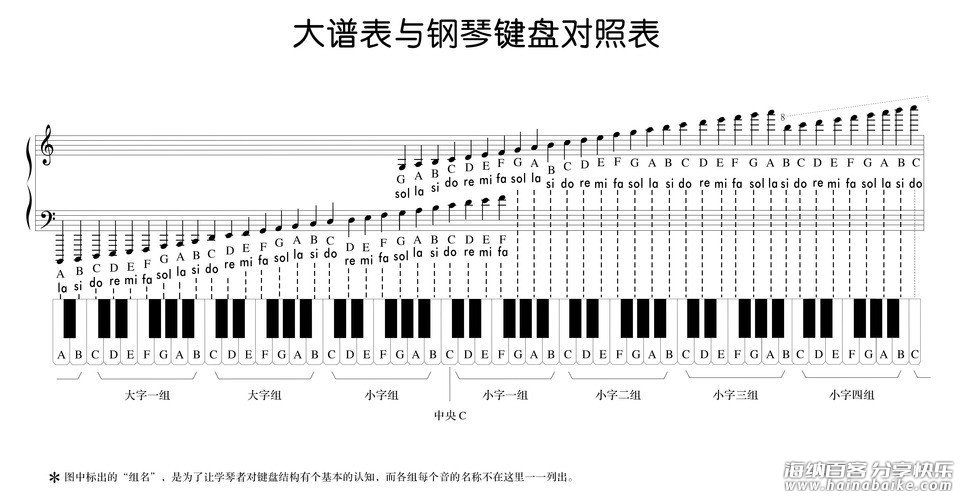
为了将个音符的音名直观的看出来,给出以下表格:

2.2 播放音乐
对照以上表格及射雕英雄传主题曲铁血丹心简谱实现树莓派播放,铁血丹心简谱如下:
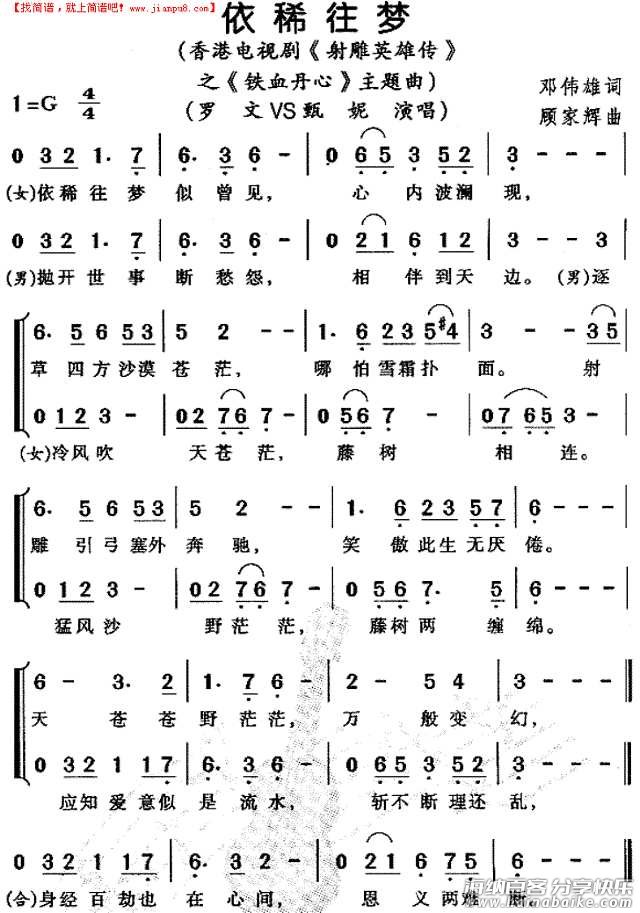
上面的简谱中缺少前奏,程序中增加了从其他版本中摘录的前奏部分,主程序tiexuedanxin.c代码如下:
#include <stdio.h>
#include <stdlib.h>
#include <stdint.h>
#include <bcm2835.h>
#include "pitches.h"
#define PWM_CHANNEL 0
typedef struct _TONE{
int freq;
int t_ms;
} TONE,*PTONE;
int pin = RPI_GPIO_P1_12;
int baseFreq = 600000; // BCM2835_PWM_CLOCK_DIVIDER_32 对应600KHz
typedef struct _melodyNode{
int note;
float fDuration;
}melodyNode;
melodyNode melody[]= {
// 1
{NOTE_A4, 1.5}, // 6
{NOTE_G4, 0.5}, // 5
{NOTE_A4, 1}, // 6
{NOTE_G4, 0.5}, // 5
{NOTE_E4, 0.5}, // 3
// 2
{NOTE_G4, 1}, // 5
{NOTE_D4, 3}, // 2
// 3
{NOTE_C4, 1.5}, // 1
{NOTE_A3, 0.5}, // .6
{NOTE_D4, 0.5}, // 2
{NOTE_E4, 0.5}, // 3
{NOTE_G4, 0.5}, // 5
{NOTE_F4, 0.5}, // 4
// 4
{NOTE_E4, 3}, // 3
{NOTE_E4, 0.5}, // 3
{NOTE_G4, 0.5}, // 5
// 5
{NOTE_A4, 1.5}, // 6
{NOTE_G4, 0.5}, // 5
{NOTE_A4, 1}, // 6
{NOTE_G4, 0.5}, // 5
{NOTE_E4, 0.5}, // 5
// 6
{NOTE_G4, 1}, // 5
{NOTE_D4, 3}, // 2
// 7
{NOTE_C4, 1.5}, // 1
{NOTE_A3, 0.5}, // .6
{NOTE_D4, 0.5}, // 2
{NOTE_E4, 0.5}, // 3
{NOTE_G3, 0.5}, // .5
{NOTE_B3, 0.5}, // .7
// 8
{NOTE_A3, 4}, // .6
{0, 1}, // 0
{NOTE_E4, 0.5}, // 3
{NOTE_D4, 0.5}, // 2
{NOTE_C4, 1.5}, // 1
{NOTE_B3, 0.5}, // .7
//
{NOTE_A3, 1.5}, // .6
{NOTE_E3, 0.5}, // .3
{NOTE_A3, 2}, // .6
//{NOTE_A3, 1}, // .6
{NOTE_A4, 0.5}, // 6
{NOTE_G4, 0.5}, // 5
{NOTE_E4, 1}, // 3
{NOTE_G4, 0.5}, // 5
{NOTE_D4, 0.5}, // 2
{NOTE_E4, 3}, // 3
{NOTE_E4, 0.5}, // 3
{NOTE_D4, 0.5}, // 2
{NOTE_C4, 1.5}, // 1
{NOTE_B3, 0.5}, // .7
{NOTE_A3, 1.5}, // .6
{NOTE_E3, 0.5}, // .6
{NOTE_A3, 2}, // .6
{0, 1}, // 0
{NOTE_D4, 0.5}, // 2
{NOTE_C4, 0.5}, // 1
{NOTE_A3, 1}, // .6
{NOTE_C4, 0.5}, // 1
{NOTE_D4, 0.5}, // 1
{NOTE_E4, 3}, // 3*/
{NOTE_E4, 1}, // 3 逐草四方
{NOTE_A4, 1.5}, // 6
{NOTE_G4, 0.5}, // 5
{NOTE_A4, 1}, // 6
{NOTE_G4, 0.5}, // 5
{NOTE_E4, 0.5}, // 3
{NOTE_G4, 1}, // 5
{NOTE_D4, 3}, // 2
{NOTE_C4, 1.5}, // 1
{NOTE_A3, 0.5}, // .6
{NOTE_D4, 0.5}, // 2
{NOTE_E4, 0.5}, // 3
{NOTE_G4, 0.5}, // 5
{NOTE_FS4, 0.5}, // #4
{NOTE_E4, 3}, // 3
{NOTE_E4, 0.5}, // 3
{NOTE_G4, 0.5}, // 5
{NOTE_A4, 1.5}, // 6
{NOTE_G4, 0.5}, // 5
{NOTE_A4, 1.0}, // 6
{NOTE_G4, 0.5}, // 5
{NOTE_E4, 0.5}, // 3
{NOTE_G4, 1.0}, // 5
{NOTE_D4, 3}, // 2
{NOTE_C4, 1.5}, // 1
{NOTE_A3, 0.5}, // .6
{NOTE_D4, 0.5}, // 2
{NOTE_E4, 0.5}, // 3
{NOTE_G3, 0.5}, // .5
{NOTE_B3, 0.5}, // .7
{NOTE_A3, 3}, // .6
{0, 1}, // 0
{NOTE_E4, 0.5}, // 3 应知爱意似
{NOTE_D4, 0.5}, // 2
{NOTE_C4, 1.0}, // 1
{NOTE_C4, 0.5}, // 1
{NOTE_B3, 0.5}, // .7
{NOTE_A3, 1.5}, // .6
{NOTE_E3, 0.5}, // .3
{NOTE_A3, 2.0}, // .6
{0, 1}, // 0
{NOTE_A3, 0.5}, // .6
{NOTE_G3, 0.5}, // .5
{NOTE_E3, 1.0}, // .3
{NOTE_G3, 0.5}, // .5
{NOTE_D3, 0.5}, // .2
{NOTE_E3, 3.0}, // .3
{0, 1}, // 0
{NOTE_E4, 0.5}, // 3 身经百劫也
{NOTE_D4, 0.5}, // 2
{NOTE_C4, 1.0}, // 1
{NOTE_C4, 0.5}, // 1
{NOTE_B3, 0.5}, // .7
{NOTE_A3, 1.5}, // .6
{NOTE_E4, 0.5}, // 3
{NOTE_D4, 2.0}, // 2
{0, 1}, // 0
{NOTE_D4, 0.5}, // 2
{NOTE_C4, 0.5}, // 1
{NOTE_A3, 1.0}, // .6
{NOTE_B3, 0.5}, // .7
{NOTE_G3, 0.5}, // .5
{NOTE_A3, 3.0}, // .6
};
void beep(int freq, int t_ms)
{
int range;
/*if(freq<2000||freq>5000)
{
printf("invalid freq
");
return;
}*/
if(freq == 0)
range=1;
else
range=baseFreq/freq;
printf("will call bcm2835_pwm_set_range freq: %d range: %d
", freq, range);
bcm2835_pwm_set_range(PWM_CHANNEL, range);
bcm2835_pwm_set_data(PWM_CHANNEL, range/2);
if(t_ms>0)
{
delay(t_ms);
}
}
void init()
{
if (!bcm2835_init())
exit (1) ;
printf("will init pin %d
", pin);
// Set the output pin to Alt Fun 5, to allow PWM channel 0 to be output there
bcm2835_gpio_fsel(pin, BCM2835_GPIO_FSEL_ALT5);
bcm2835_pwm_set_clock(BCM2835_PWM_CLOCK_DIVIDER_32);
bcm2835_pwm_set_mode(PWM_CHANNEL, 1, 1);
}
int main (void)
{
int index=0;
int nLen = sizeof(melody)/sizeof(melody[0]);
init();
for ( ; index<nLen; index++)
{
int noteDuration = 600*melody[index].fDuration;
beep(melody[index].note, noteDuration);
printf("will call bcm2835_pwm_set_data 0 after beep
");
bcm2835_pwm_set_data(PWM_CHANNEL, 0);
printf("index: %d nLen: %d@@@@@@@@@@@@
", index, nLen);
//delay(100);
}
bcm2835_pwm_set_data(PWM_CHANNEL, 0);
bcm2835_close();
return 0 ;
}
注意代码中195行做了特殊处理,这时候频率并不是为0,只是让树莓派不再发声。
转自 https://www.cnblogs.com/zhaoweiwei/p/RaspberryMusic.html
标签: 树莓派hardwareraspberrypi编程level3cgpiomultime蜂鸣器multimedia无源蜂鸣器







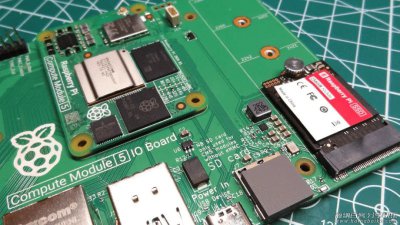
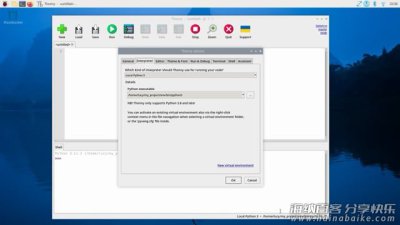
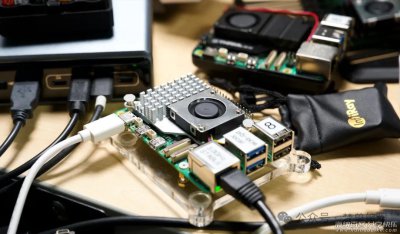
评论列表